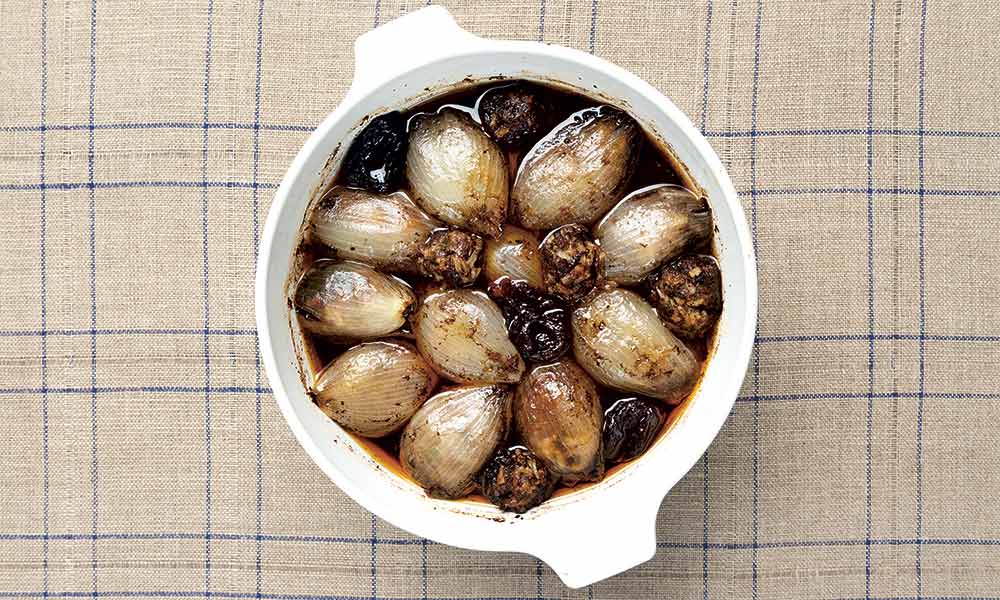Talk of the Table | The Versatile, Vengeful, Volatile Onion

I come from a family of onion lovers. My father was particularly partial to eating them raw, preferably between two slices of bread, any variety of onion would do. My mother, on the other hand, favored sweet Vidalias, as do I, but my sister usually opts for the red variety. My maternal grandmother loved cooked onions—sautéed, caramelized or fried. Normally quite mild-mannered, she reserved a special Yiddish curse for anyone who wronged her family: “Zolst vaksn vi a tzibele mitn kop in dr’erd!”—“May you grow like an onion,” she would invoke, “with your head in the ground.”
So when Moment was interested in a “Talk of the Table” about onions, I raised my hand.
One of the oldest vegetables in existence, onions in their wild form date back to Bronze Age settlements. Actually the bulb of a flowering plant, and likely a native of Afghanistan or central Asia, the onion belongs—along with its numerous relatives, garlic, leeks, chives and scallions—to the lily family (genus Allium). All of the genus’s edible forms have related flavors and odors, which are due primarily to their volatile and irritating sulfur compounds.
In his new book The Core of an Onion, Mark Kurlansky notes that onions are mild unless attacked, but when bitten or cut, they retaliate. The vengeful onion, designed to fight against mammals, “sends a toxic spittle into your eyes,” he writes. “It is said that they are spewing sulfur. In other words, they become lacrimatory and induce tears.” The molecules dissolve into the water of one’s eyes and turn into sulfuric acid, which activates nerve endings that send a message of pain to the brain. This odorless compound is completely different from the one that gives the onion its smell and strong taste. Animal lovers beware: Onions are toxic to horses, dogs, cats, guinea pigs, cattle and others.
Noted for their versatility, onions—which can be grown in a variety of soils and climates and have been cultivated for some 5,000 years—became a staple in the diets of people all over the world.
Numerous documents over the centuries describe their importance as a food and their use in art and medicine. Low in calories but high in antioxidants, vitamins and minerals, onions—whether yellow, white or red—have been used by physicians for thousands of years and are known to have a variety of beneficial effects, from reducing inflammation and the risk of heart disease and cancer to decreasing blood-sugar levels and bone loss.
Roman naturalist Pliny the Elder wrote about Pompeii’s onions and Roman beliefs about the onion’s ability to induce sleep and heal such maladies as mouth sores, dog bites, toothaches, dysentery and lumbago. Both the Greeks and the Romans fortified their athletes with onions for strength. In the Middle Ages, onions were prescribed to alleviate headaches, snakebites and hair loss; they were also used as rent payments and wedding gifts.
Maimonides, the revered rabbi, philosopher and physician of the Middle Ages, recommended feeding onions to people who were overweight. The Talmud, too, cites the benefits of onions—good for the heart and to treat a wound—but warns that eating them after bloodletting can be dangerous. The second-century rabbi Judah ha-Nasi used to state the following proverb: “Eat onions and sit in the shade” (Pesach 114a), meaning that a person should not desire luxuries and be content with what little one has.
And then there is the strange story of the “overnight onion” (Niddah 17a). It turns out that the rabbis of the Talmud warned against eating peeled eggs, onions or garlic left out overnight because they carried with them a spirit of impurity, an “evil spirit” (ruach ra’ah), and that eating any of these foods could endanger one’s life. The spirit could only be mitigated by the addition of a “significant” ingredient. Salt or oil would do. (Leaving the roots on the bulb also kept the spirit from attaching itself to the onion.)
Onions were especially important to the ancient Egyptians, who, evidence indicates, were growing them as early as 3500 BCE. Egyptians viewed the onion’s spherical shape and concentric rings as symbols of eternal life and used them in mummification and burials. Food historian Gil Marks wrote in his Encyclopedia of Jewish Cooking that “The Greek historian Herodotus noted that the workers who built the pyramids subsisted on ‘[black] radishes, onions, and leeks,’ all purported to build stamina.” According to a passage in the Hebrew Bible (Numbers 11:5), the Israelites later longed for these foods—“We remember the fish…the cucumbers, and the melons, and the leeks, and the onions, and the garlic”—while wandering in the desert.
And what about onions’ role in Jewish cookery? “From the onset, onions have been an essential and enduring element of Jewish cooking,” writes Marks, “and no contemporary form of Jewish cuisine would be complete without this pungent bulb.” By the 11th century, he continues, “salted raw onions were a common Sabbath dish in Franco-Germany. Soon chopped onions were mixed with other favorite foods, including hard-boiled eggs, fish, and chopped liver, creating classic Ashkenazic dishes. Onions remained the principal seasoning for Ashkenazim for a millennium.”
Interestingly, Marks further notes, “The Spanish Inquisition considered a sign of being a practicing Jew as ‘making their meat dishes with onions and garlic and cooking them in oil [instead of lard].’” Sephardic dishes include sevoyas reyenadas (stuffed onions) and sevoyas agras dulces (sweet and sour onions).
In the 1800s, onions became widely cultivated in Eastern Europe, making them affordable to use in Jewish recipes. Onions also lasted a long time and were easily stored over the winter months. “They were especially important in areas where spices and other seasonings weren’t readily available,” says renowned cookbook author Joan Nathan, whose new book is titled My Life in Recipes.
Which brings us again to the remarkable versatility of onions: They can be broiled, braised, boiled or baked, sauteed, stuffed, roasted or creamed. And they always “add flavor and moisture, and serve to stretch ingredients,” says Nathan. “When cooked, they add even more flavor.”
The savory, “umami-rich flavor of onions is the key to countless Jewish dishes,” says Leah Koenig, author of The Jewish Cookbook and Modern Jewish Cooking. “I love the silky texture they add to braises and stews,” she says, “and I love the sharpness they add to fresh salads.”
The Babylonian Talmud advised that “One should not eat onions from the base, but from the top.” The heart, it seems, was thought to be the best part. So whether you choose a Bermuda, Spanish or Vidalia onion to munch, keep that in mind and ponder the following words from the inimitable Julia Child: “It is hard to imagine,” she said, “a civilization without onions.”

STUFFED ONIONS A Syrian delicacy
by Leah Koenig
INGREDIENTS (serves 8)
FOR THE ONIONS:
5 large yellow onions, peeled
1/3 cup long-grain rice, rinsed and drained
1 pound ground beef
1 teaspoon ground cinnamon
1/2 teaspoon ground allspice
1/2 teaspoon ground cumin
1 teaspoon kosher salt
1/4 teaspoon freshly ground black pepper
1/2 cup finely chopped, flat leaf parsley
15 pitted prunes
FOR THE SAUCE:
1/3 cup tamarind paste or pomegranate molasses
1/4 cup red wine vinegar
3 tablespoons vegetable oil
1/4 cup light brown sugar
2 1/2 teaspoons kosher salt
3 tablespoons tomato paste
1 cup chicken or beef stock
INSTRUCTIONS
1. Slice off ends of each onion. Make a vertical slit down one side of each onion, stopping about halfway through. Place in a large saucepan and cover with water. Bring to a boil, then lower heat to medium and simmer, partially covered, until onions begin to come apart, 20 to 30 minutes. Drain and let cool, then separate individual layers and set aside.
2. Meanwhile, set a small saucepan filled halfway with water over high heat. Once boiling, turn the heat to medium, stir in the rice and cook for 7 to 10 minutes. The rice should be
al dente. Drain, and let cool, set aside.
3. Combine par-cooked rice, ground beef, cinnamon, allspice, cumin, salt, pepper and parsley, mixing well and kneading in up to 1/3 cup of water as needed, a little at a time, until meat mixture is soft and pliable.
4. Preheat oven to 350˚F. Spoon a rounded tablespoon of meat mixture into each onion layer and roll tightly to seal. Layer the stuffed onions, seam side down, and the prunes in a deep saucepan. If there is extra meat mixture left over, make 1-inch meatballs and tuck them into the saucepan.
5. Whisk together tamarind paste, vinegar, vegetable oil, brown sugar, salt, tomato paste and stock until fully combined. Pour over the stuffed onions. Cover saucepan and cook in oven, shaking the pan once or twice, until onions are very tender, about 1 hour and 30 minutes. Remove from oven and let rest for 15 minutes before serving hot.
Excerpted from The Jewish Cookbook © 2019 by Leah Koenig.
Opening picture: Photography © 2019 by Evan Sung. Reproduced by permission of Phaidon. All Rights Reserved.
Moment Magazine participates in the Amazon Associates program and earns money from qualifying purchases.



